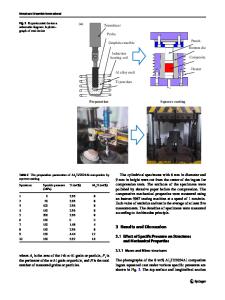In situ Al 4 C 3 nanorods and carbon nanotubes hybrid-reinforced aluminum matrix composites prepared by a novel two-step
- PDF / 1,130,495 Bytes
- 10 Pages / 584.957 x 782.986 pts Page_size
- 41 Downloads / 802 Views
In situ Al4C3 nanorods and carbon nanotubes hybridreinforced aluminum matrix composites prepared by a novel two-step ball milling Zunyan Xu1, Caiju Li1,a) Ningyu Li1
, Xiaoqing Liu1, Jianhong Yi1,b), Hongda Guan1,
1
Faculty of Materials Science and Engineering, Kunming University of Science and Technology, Kunming 650093, China Address all correspondence to these authors. e-mail: [email protected] b) e-mail: [email protected] a)
Received: 30 September 2018; accepted: 15 November 2018
In this paper, in situ Al4C3 and carbon nanotubes (CNTs) hybrid-reinforced aluminum matrix composites were prepared by a two-step ball milling (TSBM), consisting of a 24-h long-time ball milling (LTBM) and a 6-h shorttime ball milling (STBM). During LTBM, most of the CNTs were seriously damaged, and many amorphous carbon atoms derived from these damaged defects would react with Al powder to form in situ Al4C3 nanorods. Subsequently, 1 wt% CNTs were added into the composite powders for STBM to uniformly disperse CNTs into the composite powders. Compared with that of the composite prepared by one-step ball milling, the comprehensive mechanical properties of the composite prepared by the TSBM are improved obviously due to the synergistic effects of in situ Al4C3 and CNTs, and the tensile strength and elongation reached 258 MPa and 19.5%, respectively. The strengthening mechanisms of TSBM composite include fine-grained strengthening, dispersion strengthening by in situ Al4C3, and load transfer from matrix to CNTs.
Introduction In the past few decades, metal matrix composites have attracted the attentions of many researchers. Among the metal matrix composites, particle-reinforced aluminum matrix composites (PRMMCs) have a great application prospect in many fields, such as national defense, automobile, and aerospace, due to their high strength properties and light weight [1]. However, traditional PRMMCs often need to compromise between strength and plasticity after adding reinforcements. To obtain excellent comprehensive mechanical properties, previous researches on the effects of particle content [2, 3, 4, 5], shape [6], size [7], and distribution [8] on the properties of the composites have been studied. Among these factors, particles size, especially for a nanoscale size [9], plays an important role in the properties of composites. However, when the particles are nanoscale, they tend to agglomerate due to poor wettability and large surface-tovolume ratio in the matrix, which will lead to performance deterioration of the materials. Therefore, in situ formation of nanoparticles is a good way to solve this problem.
ª Materials Research Society 2019
Since the discovery of carbon nanotube (CNT) in 1991 [10], owing to its special mechanical properties [11], CNT has been considered as an ideal composite reinforcement [12, 13, 14]. As a one-dimensional nanofiber, the addition of CNTs can effectively improve the toughness of ceramic materials, which has been proved by numerous studies [15, 16, 17]. Adding CNTs and particles to metal matr
Data Loading...











